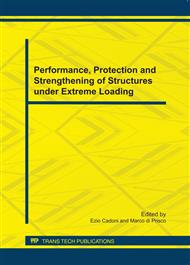[1]
R.O. Hamburger and A.S. Whittaker: Design of Steel Structures for Blast-Related Progressive Collapse Resistance. American Society of Civil Engineers (2005).
Google Scholar
[2]
J.E. Karns, D.L. Houghton, B.E. Hall, J. Kim, and K. Lee: Blast Testing of Steel Frame Moment Connection Assemblies. Proceedings of the 19th International Symposium on Military Aspects of Blast and Shock (MABS), Defense Research & Development Canada (DRDC), Suffield, Calgary, Alberta, Canada (2006).
DOI: 10.1061/40944(249)71
Google Scholar
[3]
S. Marjanishvili and E. Agnew: Comparison of Various Procedures for Progressive Collapse Analysis. Journal of Performance of Constructed Facilities (2006), pp.365-374.
DOI: 10.1061/(asce)0887-3828(2006)20:4(365)
Google Scholar
[4]
C-H. Lee, S. Kim, and K. Lee: A Parallel Axial-Flexural Hinge Model for Nonlinear Dynamic Progressive Collapse Analysis of Welded Steel Moment Frames. Journal of Structural Engineering, Vol. 136-2 (2010), pp.165-173.
DOI: 10.1061/(asce)st.1943-541x.0000102
Google Scholar
[5]
AISC: Facts for Steel Buildings - Blast and Progressive Collapse. Chicago, IL (2004).
Google Scholar
[6]
US General Services Administration: Progressive Collapse Analysis and Design Guidelines for New Federal Office Buildings and Major Modernization Projects. Washington, D.C. ( 2003).
Google Scholar
[7]
US Department of Defense: Unified Facilities Criteria (UFC): Design of Buildings to Resist Progressive Collapse. Washington, D.C. (2005).
Google Scholar
[8]
Ls-Dyna: LS-DYNA Keyword User's Manual. Livermore Software Technology Corporation, Livermore, CA (2005).
Google Scholar
[9]
A. Gupta and H. Krawinkler: Seismic Demands for Performance Evaluation of Steel Moment Resisting Frame Structures. John A. Blume Earthquake Engrg, Ctr, Rep. No. 132, Dept. of Civ. Engrg., Stanford University, Stanford, CA (1999).
Google Scholar
[10]
K. Lee, T. Kim, and J. Kim: Local Response of W-shaped Steel Columns under Blast Loading, Structural Engineering and Mechanics, Vol. 31-1 (2009), pp.25-38.
DOI: 10.12989/sem.2009.31.1.025
Google Scholar
[11]
ASCE: Minimum Design Loads for Buildings and Other Structures. ASCE/SEI 7-2005, New York (2005).
DOI: 10.1061/9780784408094.sup
Google Scholar
[12]
G. Powell: Progressive Collapse: Case Studies Using Nonlinear Analysis. Proceedings of 2004 SEAOC Annual Convention, Monterey (2004).
Google Scholar


